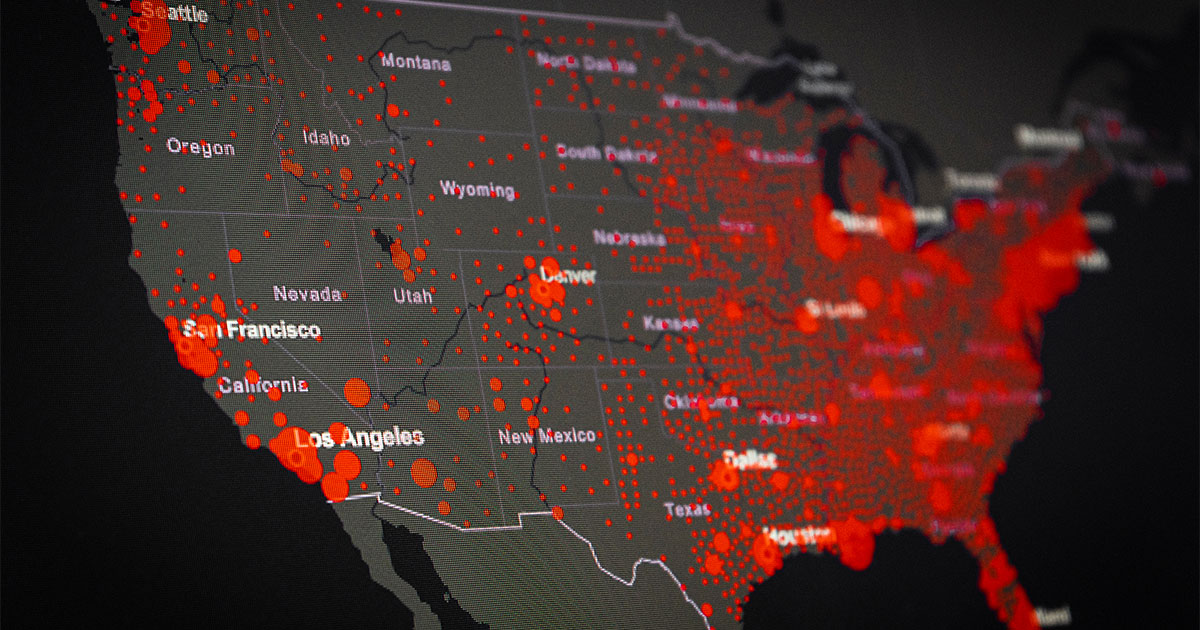The Impact of Internet Access on Covid-19 Mortality in the United States
An increase in broadband access in the US reduced Covid mortality rates, with the most significant impact in metro areas. Internet access is an increasingly important tool in the public health toolbox.
Summary
Households managing the Covid-19 pandemic relied heavily on broadband to work, learn, and secure necessary resources and information. Our new analysis finds that the internet may have been even more important in the pandemic than initially understood—for some, it was literally a matter of life and death. We find that, even after controlling for a host of other socioeconomic factors, a 1% increase in broadband access across the US reduced Covid mortality by approximately 19 deaths per 100,000, all things equal. The impact was even more stark in urban areas—in metro counties alone, a 1% increase in broadband access reduced Covid mortality by 36 deaths per 100,000, holding all else constant.
Broadband availability was important in navigating the pandemic
On May 19th, 2022, deaths from Covid-19 surpassed a million in the United States alone (Covid-19, hereafter Covid). While hope is on the horizon—with fatalities trending downward and abundance of vaccines and treatments—there are lessons to be learned from this experience that would hold us in good stead for the next public health crisis. The United States is one of the most advanced nations in the world, but according to the Census data (ACS 2016-2020), only 6% of the country’s population, on average, were working from home before the stay-at-home orders were issued in early 2020 (see summary statistics table below). One of the early responses to the pandemic was to shut down the whole country while scientists tried to figure out the virus and how it could be contained. Many people lost their jobs, and those categorized as essential workers had to go to work despite the high risk of exposure. Schools were moved online, and many jobs that could be done remotely migrated to remote operations.
The internet became essential for remote jobs, education, shopping, telemedicine, and connecting with others to carry out the functions of daily life. According to Pew Research, 90% of Americans said the internet was essential in navigating the pandemic. However, the average rate of broadband availability per county in the US is 76%: 71% for non-metro counties, and 85% for metro counties (see summary statistics table below). Some counties, including metro counties, have no broadband access whatsoever. Broadband is defined by the Federal Communications Commission (FCC) as a minimum of 25Mbps download and 3 Mbps upload speeds. Our past work, Turning America’s Digital Divide into Digital Dividends provides insights into the uneven state of broadband access in the US. The study identified four critical facets of the digital divide. These facets include access infrastructure, inclusivity, institutions, and digital proficiency. The study also examined racial, socioeconomic, and urban-rural distributions in the United States. Unsurprisingly, the same racial, geographic, and socioeconomic dynamics that led to some communities suffering disproportionately throughout the pandemic, were also found to exist in access to broadband, as defined by the FCC.
The average broadband availability across counties in the United States is 76% while the average usage is 39%.
On average, 76% of households have access to broadband across counties. “Access” is defined as the opportunity to purchase broadband internet, but does not mean that household is necessarily using broadband. The average usage of broadband across counties in the US is 39% as seen in the above table. From the correlation results below, highly educated and wealthy counties have higher broadband access than less educated and poor counties.
Broadband access, advanced education, income, and ability to work from home are negatively correlated with Covid mortality.
Correlation table below includes the correlations between county characteristics and Covid mortality rates, by county. Broadband access is negatively correlated with Covid mortality (-0.1346), even after controlling for other major factors correlated with poor Covid outcomes such as health status, income, race, and education. Comorbid conditions (Covid risk index and index of excess risk of Covid) and poverty have the highest positive correlation with Covid mortality (0.38, 0.296, and 0.298, respectively). While advanced education (-0.35), ability to work from home (-0.32), and income (-0.33) are all highly negatively correlated with Covid mortality. Black and Hispanic individuals were more likely to die from Covid than white and Asian individuals. Black households are also less likely to have broadband access than other races. Advanced education and household income have greater than 30% correlation with broadband access, while poverty, low education, and Covid risk have a high negative relationship with broadband access (see correlation table for county characteristics and broadband access). In summary statistics table, some counties have as high as 43.5% of their households receiving food stamps or SNAP. 70.2% of Households in some counties spend more than 35% of their income on rent. 47.8% of households in some counties live below the poverty level. Some counties have as high as 22.5% unemployment rate.
A 1% increase in broadband availability in the US lead to 0.1% decline in Covid mortality, all else equal.
This analysis evaluates the impact of broadband access on Covid mortality. Through the use of Poisson regression model, we show the effect of broadband access on covid mortality while holding other variables constant. After controlling for other county-level characteristics such as crowded living conditions, type of transportation used, barriers to social distancing, access to health care, comorbid conditions, age and gender, poverty indicators, and structural racism as recommended by Scannell et al. (2020) (note: we could not control for air quality due to data availability), we found that a 1% increase in broadband access across the US leads to 0.1% decline in Covid mortality, all else equal (see Poisson regression result table below). This can further be interpreted as a 1% increase in broadband access could reduce Covid mortality by approximately 19 people per 100,000 people across the US. This model explained 71% variation in Covid mortality (R-square=0.7137). Curiously, while broadband access did not have a significant impact among non-metro counties, it was associated with a decrease in Covid mortality by approximately 36 people per 100,000 among metro counties. Covid mortality in this study only covers pre-vaccine periods (Jan 2020 to Feb 28, 2021). The impact of broadband access found in this study is conservative. For instance, the impact of high-speed internet in accessing Covid vaccines in the early phases of vaccination was not captured here. For example, in Jan 2021, Shelby County, Tennessee, made weekly vaccine slots available on a Friday for eligible residents to make appointments online without considering that those that did not have internet access could only call in on Monday. By late Saturday night, all the 10,800 appointment slots were taken, denying those without internet early access to the vaccine. However, given the political context and conspiracy theories that surrounded vaccines especially in the early stages, we excluded the post-vaccine period. The total number of Covid deaths covered in this study is 507,557.
Some county characteristics are important in metro counties but not so in non-metro counties.
It is important to note that other county characteristics beyond broadband access such as crowded living conditions, transportation, dense housing, other barriers to social distancing, health care access, comorbid conditions, age and gender, poverty and race all had a significant impact on Covid mortality across the US. For more on these factors see Poisson regression result table above. Like broadband access, the impact of some factors on covid mortality in non-metro counties is different from their impact in metro counties.
The impact of broadband availability is not significant among non-metro counties but significant in metro counties.
Among non-metro counties, broadband access does not significantly affect Covid mortality but has a significant negative impact among metro counties. A 1% increase in broadband access could lead to 0.24% decline in Covid mortality among counties in metro areas, all else equal. This can be further interpreted as on average, a 1% increase in broadband access could lead to a decline of Covid mortality by 36 deaths per 100,000 across metro counties. The model explained 76% variation in Covid mortality among metro counties (R-square=0.7554).
The poorer the county, the lower the broadband access.
Social economic poverty is higly correlated with broadband poverty (see correlation tables above) which will impact, among other things, access to public health information, ability to social-distance and so on. Broadband poverty is more prevalent in poor counties than in their wealthy counterparts. Access to information was a crucial element that determined survival especially during the early phases of the pandemic when the CDC was constantly releasing recommendations on how to stay safe. Households that do not have access to internet or are unable to afford internet facilities are likely to be laggards in receiving critical information, complying with the emerging guidance and recommendations, and taking measures to save their lives and that of loved ones. Note, the impact of some socio-economic factors such as dense housing is different between metro and non-metro counties. The presence or lack of some socio-economic factors may be an indication of poverty in non-metro areas but may not imply poverty in metro areas. For instance, while dense living in non-metro areas maybe an indicator of poverty, this may not be true for large cities like New York City.
Metro dwellers are different from non-metro dwellers.
The variations in the impact of socio-economic factors on covid mortality may be attributable to the sizeable differences between metro counties and non-metro counties. For instance, there are more average nominal Covid deaths in metro counties than in non-metro counties, whereas the Covid mortality rate by population is higher in non-metro counties than in metro counties. Also, factors that are highly positively correlated with broadband access such as advanced education and household income are higher on average among metro counties than non-metro counties. While those that are negatively correlated with broadband access such as poverty, Covid risk index, and low education are lower on average among metro counties than non-metro counties. Metro dwellers are better educated, have higher incomes, and have different occupational dynamics from non-metro dwellers.
Methodology
For this study, we collected data from various sources, which are available here. STATA statistical package was used to merge and analyze data. A Poisson regression model was used to analyze the data with offset equal to population. The R-square was calculated using

Covid death is defined as the sum of daily Covid death per county from January 1, 2020 to February 28, 2021. We restricted the data to the pre-vaccine era because of the availability of Covid vaccines which became accessible and effective in March 2021.
We interpreted the impact of broadband access on Covid mortality as a one percent increase in broadband access will lead to (exp(beta*1) – 1) * 100% change in Covid mortality. To validate the inclusion of broadband access in the model, we conducted a likelihood-ratio test by excluding broadband access in a model and comparing the two models; the result shows that broadband access should be included in the model.
Digital Planet Research Analyst Abidemi Adisa worked on the analysis under the guidance of Bhaskar Chakravorti, Ravi Shankar Chaturvedi, and Christina Filipovic.
This research is a part of the IDEA 2030 initiative, made possible by the generous support from the Mastercard Center for Inclusive Growth.














